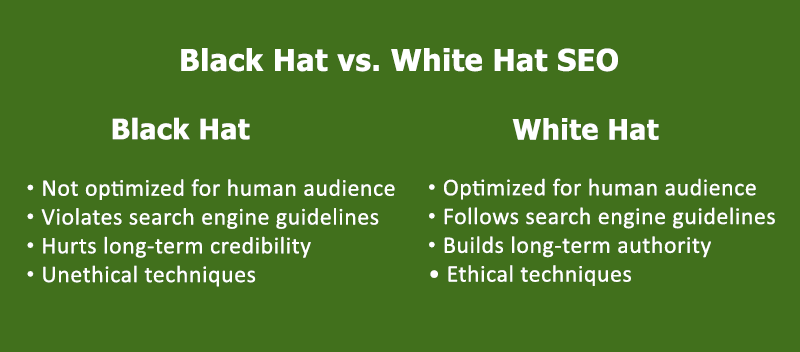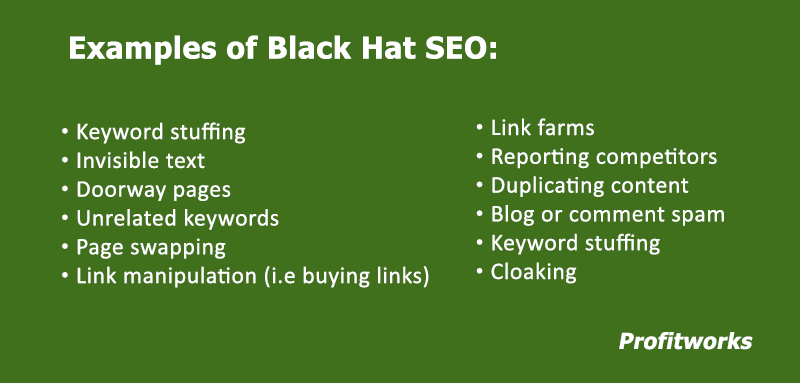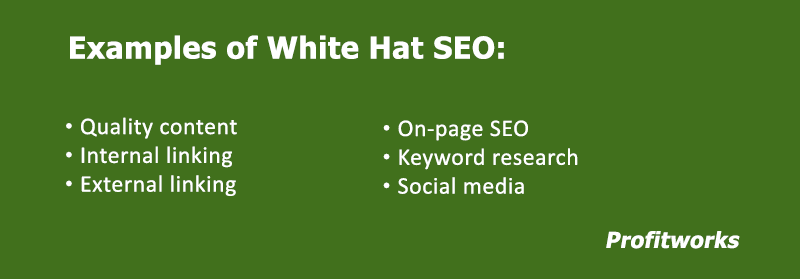Black Hat vs. White Hat SEO: What’s the Difference?

Like most brands with an online presence, you’re likely wondering how to optimize your content to reach the top of Google’s search engine rankings. What most people don’t realize, however, it that not all SEO is the same - much of search engine optimization can be categorized into two separate forms: black hat SEO and white hat SEO.
One of these forms of SEO is ethical, meets Google’s search engine guidelines, and builds genuine digital authority, while the other violates search engine guidelines, and may lead to your webpage being banned. Do you know which strategy your business is using?
Looking to launch an SEO strategy? For full SEO services, contact Profitworks today.

What is Black Hat SEO?
In order to evaluate whether or not your SEO strategy is ethical, it’s important to first understand what each form of SEO entails. Black Hat SEO is the use of manipulative techniques to increase a web page’s visibility or rank in search results. Not only do black hat techniques fail to optimize content for a human audience, but they also violate Google’s search engine guidelines. This form of search engine optimization can be highly detrimental to your credibility as a business or content creator.
Techniques like keyword stuffing, invisible text, doorway pages, unrelated keywords, page swapping, link manipulation, and link farms, to name a few, have all been deemed unethical by Google. These strategies illegitimately skew search engine results, inhibiting the ability of the engine to provide the content that is most valuable to the person searching.

While a black hat strategy has the potential to generate quick results, the long-term ramifications vastly outweigh the short-term gratification. From a ranking perspective, black hat techniques will hurt your website’s traffic and long-term credibility, actually threatening your visibility over time. In the worst case, you may actually be penalized or banned from search engines entirely. The most detrimental effect of black hat SEO, however, is arguably the perception of your business it creates for your customers. Using spammy tactics to drive them to your website will result in a loss of trust between your brand and your customers, hurting not only your ranking but also your sales.
What is White Hat SEO?
White Hat SEO, on the other hand, is the use of search engine optimization techniques that have a human audience in mind. Rather than manipulating the search engine, white hat SEO techniques work with the search engine in order to improve the likelihood of your content meeting the end user’s needs.
By creating high-quality content using white hat strategies like keyword analysis, linking, and writing for a human audience, your web pages will develop organic rankings over time. Google’s mission is to provide useful results to its users, and your commitment to following their rules and policies will have long-term benefits for your website. Not only will you build credibility and authority on the web, but your content will also continue to bring the right traffic and leads to your website as well.
5 Proven White Hat Strategies You Can Use Today
Now that you understand the benefit of using white hat SEO, you may be wondering what this looks like in practice. To help you make the best content possible, we’ve researched and compiled the top five white hat techniques.

1. Create Quality Content
Unsurprisingly, the best way to rank for the questions your target market is asking is to provide the best possible answers to those questions. Not only does this mean taking the time to write quality content, but also taking the time to consider how your content is organized. By striking the right balance between headers, ratio of text to images, white space and media quality, you’ll not only increase the time users spend on your page, but also the traffic driven to it.
Related topic: Google Ranking Factors - #1 is Content
2. Internal and External Linking
Linking is a critical tool in building the right associations to your content on the web. Through internal linking on keywords you’ve already created quality content for, you can support the reader’s journey in learning more about the topics that you’re an expert on—increasing their time spent on your website. With every external link to similar, relevant pieces of content on the web, you have the power to create associations that search engines will consider when generating results. For example, if you’re writing about home building and choose to link to the Canadian Home Builder’s Association, you’re creating an association with an industry leader who has already built authority on the web.
The power of linking goes beyond your own content, though. What’s even more powerful than your own internal or external links is the number of times that other, authoritative web pages link to your content themselves. Each of these “backlinks” is essentially a vote of confidence for your content, telling search engines that what you’re sharing is worth reading. Not sure how to get other web pages interested? Start by simply reaching out to web pages with content similar to yours and asking them to link to you where possible.
Related topic: The Importance of Links to your Website’s Google Ranking and SEO
3. On-Page SEO
Although it’s often reduced to the words on your web page, search engines look at much more than just your body text. In order to fully optimize your pages for the web, be sure to include your keyword in headers, the meta description, URL, and even images. Each of these components of on-page SEO plays a critical role in Google determining how well your content relates to the keyword you’re trying to rank for.
4. Keyword Research
Keyword research has the potential to make or break the success of your content. If your target market is not searching for the content you’re creating, it simply won’t be found—regardless of how strong it truly is. Taking time to put yourself into the shoes of your target market and asking yourself the questions they are asking will allow you to create the content that’s needed. To support your keyword research, consider using tools like Google AdWords and Search Console to find opportunities to fill gaps in the content that your target is looking for.
Related topic: Keyword Phrase Research
4. Social Media
Social media is one of the most effective ways to show search engines that there’s a community around your content. Not only do social media shares have a big impact on Google rankings, but having a social media presence provides another avenue for backlinks and additional traffic to your website. Having an active social presence acts as a signal that your content is both credible and trustworthy.
White Hat SEO: the Winning Strategy
It’s clear that white hat SEO is the best solution in creating long-term credibility for your brand online. White hat techniques like quality content, linking, on-page SEO, keyword research, and social media will drive the right traffic to your pages, generating genuine leads for your business. Taking the time to invest in your SEO strategy is critical to creating the digital authority you’re looking for.
Unsure how to get started? At Profitworks, we are a team of marketing and white hat SEO experts with a specialization in making our client’s websites climb to the top of Google rankings. Looking to drive customers to your website and build your brand’s digital authority? Contact us for a free quote today.
"Our overall sales to new customers has improved as a result of detailed analysis, proposed solutions and successful execution" -Tom (Business Owner & Customer)

